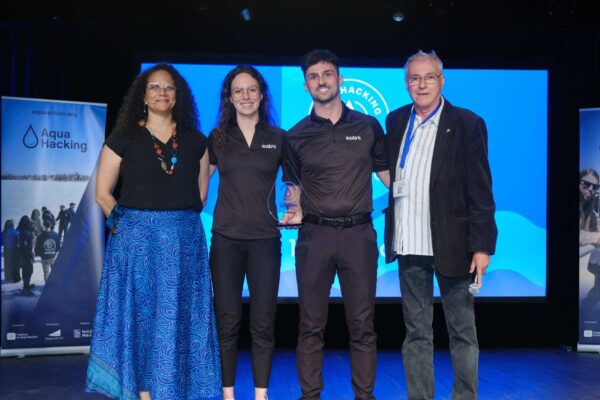- Overview
The series “Tour d’horizon en trois questions” highlights research in all its forms and offers an informed perspective on current issues.

What do geomatics specialists do? While this science—at the intersection of geography and technology—has many applications, Professor Karem Chokmani has devoted most of his career to developing risk management tools… for floods!
His research, which combines artificial intelligence (AI), computer science, and hydrological modeling, has led to the creation of operational solutions that improve flood forecasting at various scales. As such, he has supported numerous municipalities, regions, and cities in protecting flood-prone areas—a challenge that will become even more pressing with the acceleration of climate change.
In addition to his academic duties, Professor Chokmani serves as Co-Director of the nature and technology axis of the Réseau Inondations InterSectoriel du Québec (RIISQ). He is also the Scientific Director of both the Drone-Based Environmental Remote Sensing Laboratory and the Northern and Environmental Remote Sensing Laboratory, based at the Eau Terre Environnement Research Centre of the Institut national de la recherche scientifique (INRS).
To learn more about how geomatics applies to real-world challenges, Professor Chokmani answers our questions.
What are the main types of flood risks currently observed in Québec?
Québec faces a wide variety of flood risks, depending on the season, climate conditions, and the physical characteristics of each region. We generally distinguish four types of flooding: river (fluvial), pluvial, coastal, and ice-jam flooding. Our team focuses on all four, with particular attention to fluvial and ice-jam floods, which can reach significant magnitudes in Québec.
Fluvial floods, common in spring, are caused by rising river levels, typically fed by snowmelt and heavy rainfall. These floods affect areas such as Montérégie, Outaouais, and Saguenay. In contrast, pluvial floods occur in urban areas, especially during intense storms. Cities like Montréal and Toronto have experienced such events in recent years, often due to saturated or aging sewer systems, which are difficult to model using traditional tools.
Ice jams are typically a winter phenomenon. They form when large masses of ice accumulate at a blockage point along a river, causing a rapid rise in upstream water levels. They are often compared to a “river traffic jam.” This phenomenon is complex, multifactorial, and difficult to predict without a detailed understanding of weather, hydrological, and topographic conditions.
Finally, coastal floods mainly affect the St. Lawrence estuary and gulf. They are caused by a combination of storms, high winds, and large tides, exacerbated by rising sea levels.
To study and prevent these risks, we’ve been working closely with Québec’s Ministry of Public Security (MSP) for over a decade. Recently, we announced that MSP analysts will now use one of our models to monitor ice formation across the province. This collaboration between INRS and the MSP has enabled us to develop a technological solution tailored to Québec’s climate realities.
What technologies and tools are used to detect environmental or human risks related to flooding?
Flood risk detection and management now rely on an increasingly sophisticated array of technologies that combine Earth observation, modeling, and AI. The goal is to better anticipate extreme events, map risk areas, and support both operational and strategic decision-making. Scientific research directly informs smart decision-making—not just to reduce property and infrastructure damage, but more importantly, to save lives.
Remote sensing plays a central role in this process. It enables near-real-time monitoring of water levels, ice cover, runoff, and soil saturation. Radar satellites, such as those in the Sentinel and RADARSAT constellations, are particularly effective for detecting flood extent—even under cloud cover or at night.
We supplement this satellite data with high-resolution drone surveys to map urban zones, inspect infrastructure, or model local topography. Drones are valuable both during emergencies and in post-disaster assessments.
We also use hydrological and hydraulic models to simulate river flow, water levels, and potential overflows. These models are fed with weather data, soil maps, digital elevation models, and climate forecasts.
AI now enhances the accuracy of predictive models by integrating large datasets and detecting weak signals or complex patterns. Our teams, for example, are developing deep learning algorithms capable of automatically detecting ice jams on rivers.
Finally, interactive mapping platforms make information accessible to local authorities, the public, and policymakers, helping to optimize flood preparedness and prevention. Our research teams contribute to these platforms and help disseminate relevant information.
How can cities protect themselves from flood risks today using science?
Our work involves supporting cities with scientific and technological tools: flood forecasting models, hazard and vulnerability maps, risk assessments for critical infrastructure, and simulations of future scenarios in the context of climate change. These tools help inform decision-making by elected officials and municipal managers alike.
Flood protection for cities no longer depends solely on physical infrastructure like levees or retention basins. Today, science offers integrated approaches that combine resilient urban planning, environmental data, and citizen engagement.
Municipalities play a frontline role. In partnership with scientists and organizations such as the Fédération québécoise des municipalités (FQM), they increasingly integrate flood risk mapping into land-use planning. This helps prevent new construction in vulnerable areas and better protect existing neighborhoods.
Lastly, public awareness is essential to ensure communities are well-prepared. It’s vital that citizens understand the risks and know how to respond in case of flooding. Through interactive maps, mobile apps, and public information campaigns, science helps make this knowledge accessible and actionable.
In my view, science can support cities both upstream—through prevention—and downstream—through crisis management—to build a stronger, more resilient society in the face of water-related hazards. This goal is at the heart of our research.



